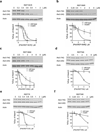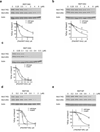Allele-selective inhibition of ataxin-3 (ATX3) expression by antisense oligomers and duplex RNAs
- PMID: 21294677
- PMCID: PMC3908450
- DOI: 10.1515/BC.2011.045
Allele-selective inhibition of ataxin-3 (ATX3) expression by antisense oligomers and duplex RNAs
Abstract
Spinocerebellar ataxia-3 (also known as Machado-Joseph disease) is an incurable neurodegenerative disorder caused by expression of a mutant variant of ataxin-3 (ATX3) protein. Inhibiting expression of ATX3 would provide a therapeutic strategy, but indiscriminant inhibition of both wild-type and mutant ATX3 might lead to undesirable side effects. An ideal silencing agent would block expression of mutant ATX3 while leaving expression of wild-type ATX3 intact. We have previously observed that peptide nucleic acid (PNA) conjugates targeting the expanded CAG repeat within ATX3 mRNA block expression of both alleles. We have now identified additional PNAs capable of inhibiting ATX3 expression that vary in length and in the nature of the conjugated cation chain. We can also achieve potent and selective inhibition using duplex RNAs containing one or more mismatches relative to the CAG repeat. Anti-CAG antisense bridged nucleic acid oligonucleotides that lack a cationic domain are potent inhibitors but are not allele-selective. Allele-selective inhibitors of ATX3 expression provide insights into the mechanism of selectivity and promising lead compounds for further development and in vivo investigation.
Figures







References
-
- Alves S, Nascimento-Ferreira I, Dufour N, Hassig R, Auregan G, Nobrega C, Brouillet E, Hantraye P, Pedroso de Lima MC, Deglon N, et al. Silencing ataxin-3 mitigates degeneration in a rat model of Machado-Joseph disease: no role for wild-type ataxin-3? Hum. Mol. Genet. 2010;19:2380–2394. - PubMed
-
- Boy J, Schmidt T, Wolburg H, Mack A, Nuber S, Bottcher M, Schmitt I, Holzmann C, Zimmermann F, Servadio A, et al. Reversibility of symptoms in a conditional mouse model of spinocerebellar ataxia type 3. Hum. Mol. Genet. 2009;18:4282–4295. - PubMed
-
- De Souza EB, Cload ST, Pendergrast PS, Sah DW. Novel therapeutic modalities to address nondrugable protein interaction targets. Neuropsychopharmacology. 2009;34:142–158. - PubMed
Publication types
MeSH terms
Substances
Grants and funding
LinkOut - more resources
Full Text Sources
Other Literature Sources
